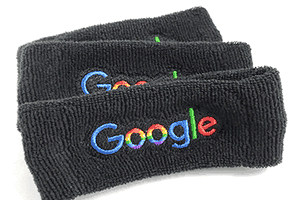While you may have mastered twills and tees, other fabrics on the other hand, may still present a challenge. We are going to focus on digitizing and embroidering on the more difficult types of fabric.
Pique
Pique, tees’ knottier cousin, has a certain weave to it that gives it it’s unique texture. However, this bumpi¬ness can wreak havoc on embroidery. For digitizing I recommend increasing your density only slightly and if room in the columns for satin stitching allows, then increase the type of underlay.
Whereas you may normally use zigzag underlay, try using double zigzag instead. It helps keep the satin stitches on top, limiting how the texture of pique can influence the edges of the columns.
The texture of pique can show through the top stitch¬ing more than tees or twill. Water soluble topping can help clean up the edges of the embroidery while also improving the vibrancy of the stitches.
Towels
Linen kitchen towels can just be treated like twill. Your standard bath towel is the terry cloth variety and can have different heights of loops. This looped fabric can separate the stitching of embroidery and even fall over the design and cover your design.
Increasing the density of your top stitching and using more underlay will help as long as your column width is on the bolder side. The fabric’s pile may cover your design or small letters even with water soluble topping.
A knockdown or tackdown stitch can be your friend. This is an open fill stitch with another open fill under¬lay that crosses in the opposite direction (also known as Tatami or Lattice.) This effect should be made the same color as the fabric so as not to be obtrusive. Cre¬ate a shape that extends past the desired area by about one-eighth inch or more, if the pile of the fabric is extra-long. This can be a simple block shape or more of a contour shape around the letters or design.
Fleece
I know it’s summer time and talking about fleece may seem premature, but as I write over here in the Pacific Northwest, it is currently 54°F, and we’re all bun¬dled up right now. We will discuss the different types of fleece.
Sweats
The typical sweatshirt is a heavy fabric with a fuzzy inside and has a considerable amount of stretch. Although sweats have no pile, they do have a certain amount of sink to it. Pull compensation should be increased to around .22-.26 mm. Density should be increased by 10-15% in addition to almost doubling the underlay. Double zig zag underlay for wider satin columns and double layer of tatami underlay for areas with fill stitch.
Polar Fleece
This is the most common type of fuzzy fleece. It is fuzzy with a high pile, usually around a quarter or more. This fuzziness can fall over the embroidered design covering up essential parts. Both polar fleece and mi¬cro fleece tend to be really stretchy, so cut away back¬ing may be necessary to add support.
Like pique or towels, the underlay will need to be increased. For satin stitches you will need to double up the normal underlay. Edge run is less necessary on polar fleece. Increase your pull compensation and your density.
Although solvy can be used on fleece I find it more dif¬ficult to steam out in post-production. A knockdown/tackdown stitch is going to help with any small letter¬ing or important detail that otherwise may get covered by the surrounding fleece.
Micro Fleece
The other type of fuzzy fleece is micro fleece. Mi¬cro fleece has a low pile but tends to be really dense. Program your design the same way you would polar fleece. If small lettering or detail is in the logo, instead of using a tackdown stitch, use your normal fill stitch (keep it the same color as your fabric.) The pile of micro fleece tends to want to stick out more despite the lower height.
Columns not looking wide enough on fleece? Don’t just increase you pull comp, also increase the column width. Look to see if your software allows you to increase the column width without using pull com¬pensation. What’s the difference you may ask? Your underlay’s location is based on the edge of the shape. Increasing the pull comp will further the distance from that underlay. The underlay can become less useful the further away from the edge of the top stitching.
(put photos of pull comp and underlay here)
In conclusion, don’t just try increasing your density, instead, increase your underlay and pull compensation. Water soluble topping can be helpful on towels and pique but can be difficult to pick out in post-produc¬tion. A knockdown stitch can be helpful in keeping the pile of your fabric at bay.
Jesse Elliott is digitizing production manager for Ignition Drawing.





